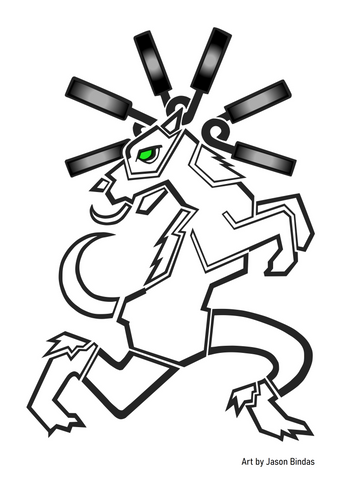
The Myth of the Dog Leg

It's the dawn of time. Mist snakes through saplings in the sun-filtered primordial understory. Somewhere in the canopy, a bird or a monkey--it's hard to tell which--discharges a raucous series of reports. Either it's loud enough to echo or has been answered by more bird-monkey critics. Maybe if you were more comfortable on the stage of this ersatz theater, then the crowded canopy wouldn't sound so much like laughter.
"Place the straight leg in your palm," it says--or at least you think it said. In hindsight, you cannot recall if the beast actually spoke. You try this placement with the gripper and it feels good. You like this. For a split second, "Why?" bubbles to the surface only to fizzle when you consider who told you. You grasp this newfound awareness with a veracity reserved for truths, such as gravity and death. You decide then and there you will always position a gripper with the straight spring leg in your palm. Forever and ever until gravity takes your youth and death takes your existence.
What is a dog leg?
Okay, okay, we admit it probably didn't happen that way. But can you really say that how you found out about the dog leg was much different?
Most grippers will have an observable "dog leg." That is, a straighter spring leg going into the coil. This results from the manufacturing process. The leading spring leg will be straighter because it is braced as the coil is wound around a mandrel. The trailing leg is the more curved leg. Not all grippers even have a clear distinction between the two spring legs. So the dog leg does exist in this sense, but observable is not the same as meaningful.

Two sides of the same gripper. The straighter "dog leg" is on the right.
Where did the term originate?
This idea of a difference in the spring legs goes back to research on torsion spring grippers done by Piedmont Design Associates (PDA) between 2001 and 2003. PDA was a sports equipment manufacturer that mainly produced precision fractional plates for micro-loading, but also carved out a niche for grip strength equipment.
Their research was ignited by a spark from the grip community when asked a seemingly simple question about performing gripper negatives. Troubleshooting that single question sent them tumbling down a rabbit hole of further gripper investigations. The resulting 40+-page eBook called Torsion Spring Grippers reads as a series of novel discoveries they were eager to try and understand, like curiosity-fueled exploration. They methodically tested and formed hypotheses and you get the story essentially as it unfolds. The eBook is undeniably thorough and insightful.
Working like a dog
PDA coined many phrases and innovated numerous devices to aid in their gripper research. The first of two main devices was called "The Nutcracker," and was used to cycle reps on grippers. PDA correctly identified that new gripper springs initially lose a small amount of strength and then stabilize. The second preeminently named device was called "The Standard of Strength Press" or SOSP. The SOSP was basically a steel frame that held a bottle jack, which could be used to press a gripper shut and get a force readout in inch-pounds.

Left: The "Standard of Strength Press" (SOSP) used to rate grippers.
Right: "The Nutcracker" used to cycle grippers and stabilize the spring.
"We tested in both directions and it did make a difference. The final, full closure, static inch-pounds was the same. But it took less effort (lower readings) at the start if the dog leg was positioned at the top. The top is stationary acting like the palm when a gripper is closed. We shared these results and savvy gripsters adopted the suggested technique of planting the dog leg against the palm."
The Hound of the Ask-Yourselves
So--ask yourselves--PDA said the dog leg matters, right? Well, the main thing is they confirm the final measurement was the same either way. They just felt the dog leg made a difference at the very beginning of a close, in their device, right when the handle started moving. This is the main clarification, which has gotten lost over time. Really, the mythical part of this tale was spun by the grip community when PDA's advice was passed around word-of-mouth with slight changes and no context.We cannot corroborate the myth of the dog leg in our research at Cannon PowerWorks. For any measurements that we can take of the beginning strength of a gripper, the numbers are not different based on positioning. We inquired about this with three separate spring manufacturers and all agreed there is no basis for the theory. Finally--another ask yourselves--if you set the gripper at all, then the very beginning of the close is irrelevant anyway, right?
Barking up the wrong tree

The longer lever on the right side should go in your fingers.
The dog leg as dogma
Every time before a race, Michael Phelps does the same double-arm slap on his back. Many gripsters habitually place the dog leg in their palm. We feel this is no different than the back slaps. It's not worthless, but it's personal. It is not related to the race or the pool or the gripper or anything else. It's for the benefit of the athlete and nobody else. We would disagree with an argument that the positioning grants an advantage beyond this kind of ritualistic repetition. Even if that is worthwhile, you should understand why you're performing the ritual and not just repeating it blindly.
Let sleeping dogs lie

